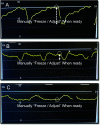Esophageal Pressure Measurement: A Primer
- PMID: 37433629
- PMCID: PMC10468172
- DOI: 10.4187/respcare.11157
Esophageal Pressure Measurement: A Primer
Abstract
Over the last decade, the literature exploring clinical applications for esophageal manometry in critically ill patients has increased. New mechanical ventilators and bedside monitors allow measurement of esophageal pressures easily at the bedside. The bedside clinician can now evaluate the magnitude and timing of esophageal pressure swings to evaluate respiratory muscle activity and transpulmonary pressures. The respiratory therapist has all the tools to perform these measurements to optimize mechanical ventilation delivery. However, as with any measurement, technique, fidelity, and accuracy are paramount. This primer highlights key knowledge necessary to perform measurements and highlights areas of both uncertainty and ongoing development.
Keywords: PEEP; esophageal pressure measurement; lung-protective ventilation; mechanical ventilation; respiratory system driving pressure; transpulmonary driving pressure.
Copyright © 2023 by Daedalus Enterprises.
Conflict of interest statement
Dr Mireles-Cabodevila discloses a relationship with IngMar Medical. Mr Chatburn discloses relationships with IngMar Medical, Inovytec, Ventis, AutoMedx, Vyaire, Aires, and Stimdia. The remaining authors have disclosed no conflicts of interest.
Figures








Similar articles
-
Pleural and transpulmonary pressures to tailor protective ventilation in children.Thorax. 2023 Jan;78(1):97-105. doi: 10.1136/thorax-2021-218538. Epub 2022 Jul 8. Thorax. 2023. PMID: 35803726 Review.
-
Esophageal Manometry and Regional Transpulmonary Pressure in Lung Injury.Am J Respir Crit Care Med. 2018 Apr 15;197(8):1018-1026. doi: 10.1164/rccm.201709-1806OC. Am J Respir Crit Care Med. 2018. PMID: 29323931
-
Effect of Esophageal Pressure-guided Positive End-Expiratory Pressure on Survival from Acute Respiratory Distress Syndrome: A Risk-based and Mechanistic Reanalysis of the EPVent-2 Trial.Am J Respir Crit Care Med. 2021 Nov 15;204(10):1153-1163. doi: 10.1164/rccm.202009-3539OC. Am J Respir Crit Care Med. 2021. PMID: 34464237 Free PMC article. Clinical Trial.
-
Esophageal pressure monitoring: why, when and how?Curr Opin Crit Care. 2018 Jun;24(3):216-222. doi: 10.1097/MCC.0000000000000494. Curr Opin Crit Care. 2018. PMID: 29601320 Review.
-
Should we titrate peep based on end-expiratory transpulmonary pressure?-yes.Ann Transl Med. 2018 Oct;6(19):390. doi: 10.21037/atm.2018.06.35. Ann Transl Med. 2018. PMID: 30460264 Free PMC article.
Cited by
-
Estimation of transpulmonary driving pressure using a lower assist maneuver (LAM) during synchronized ventilation in patients with acute respiratory failure: a physiological study.Intensive Care Med Exp. 2024 Oct 4;12(1):89. doi: 10.1186/s40635-024-00674-z. Intensive Care Med Exp. 2024. PMID: 39365383 Free PMC article.
References
-
- Garegnani LI, Rosón Rodriguez P, Franco JVA, Escobar Liquitay C. Esophageal pressure monitoring during mechanical ventilation in critically ill adult patients: a systematic review and meta-analysis. Med Intensiva 2021;45(7):387–394. - PubMed
-
- Robin ED. The cult of the Swan-Ganz catheter. Overuse and abuse of pulmonary flow catheters. Ann Intern Med 1985;103(3):445–449. - PubMed
-
- Akoumianaki E, Maggiore SM, Valenza F, Bellani G, Jubran A, Loring SH, et al. ; PLUG Working Group (Acute Respiratory Failure Section of the European Society of Intensive Care Medicine). The application of esophageal pressure measurement in patients with respiratory failure. Am J Respir Crit Care Med 2014;189(5):520–531. - PubMed
MeSH terms
LinkOut - more resources
Full Text Sources

